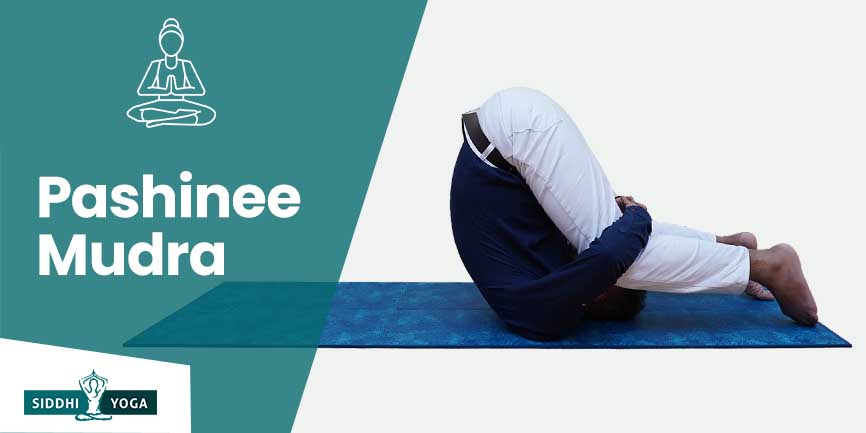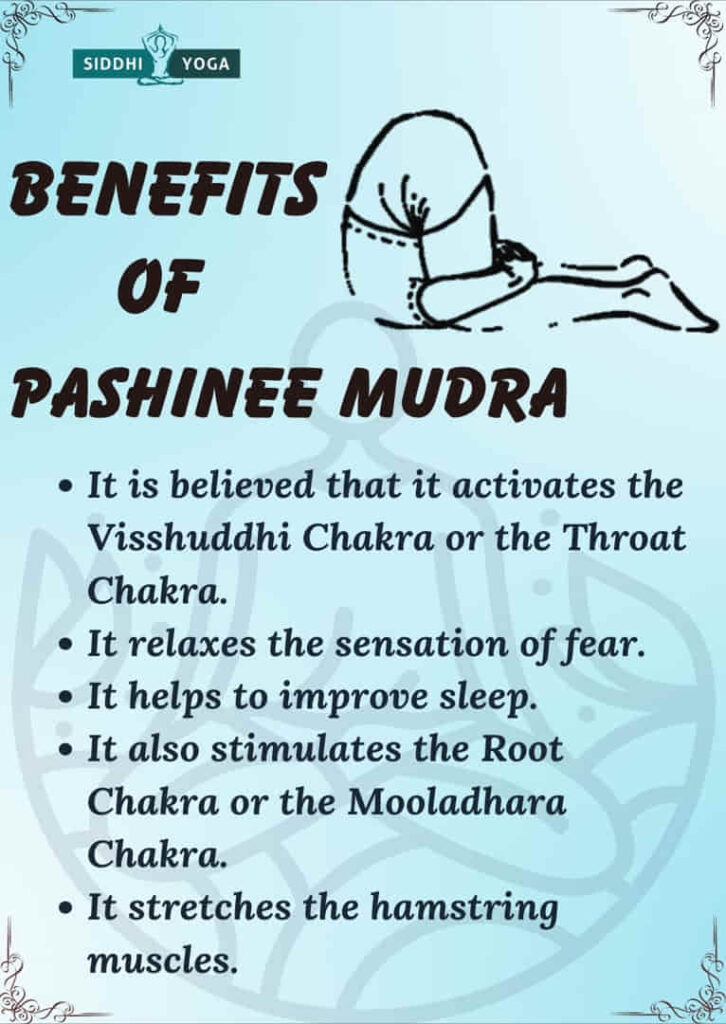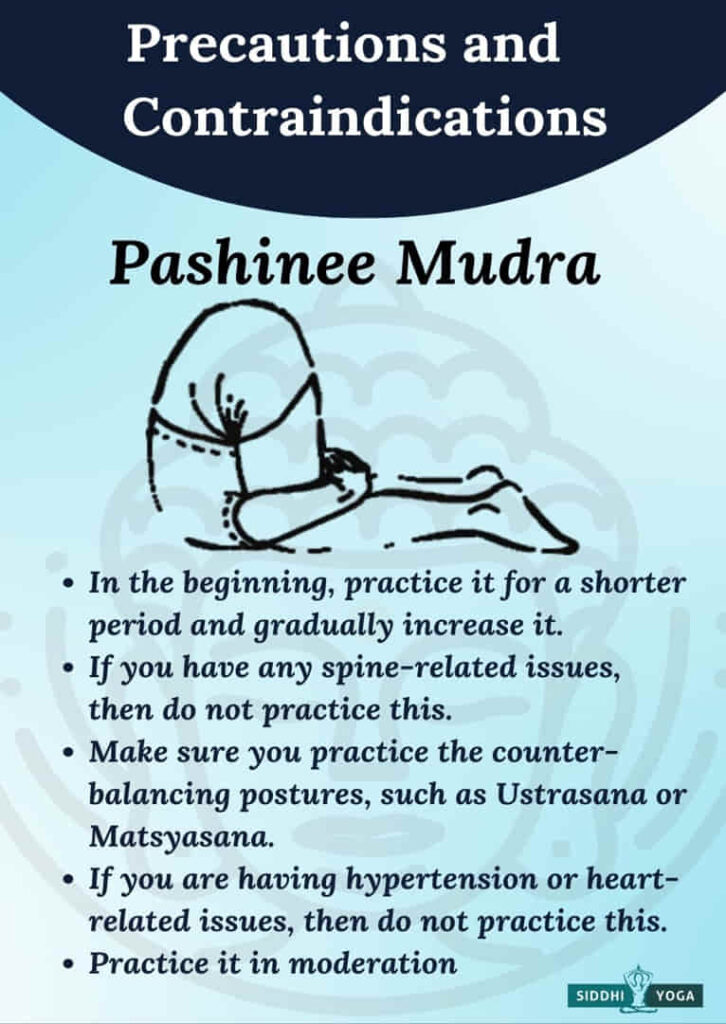
Discover the meaning of Pashinee Mudra, how to do it, and the benefits of Pashinee Mudra for your health and well-being.
Definition – What is Pashinee Mudra and its Meaning, References, and Mythology?
Pashinee Mudra is one of the Mudras, which includes bodily postures. Hence it is called one of the postural Mudras or Kaya Mudras. Practicing this Mudra involves assuming Halasana or Plow pose. To understand this Mudra better, let us simplify its meaning.
Pashinee – Here, “Pashini/Pashinee” is used to describe a “noose.”
Mudra – “Mudra” is used to describe a posture/seal.
So, collectively it can be called the “Noose seal.”
The practice of Pashinee Mudra includes performing the Hatha Yoga postures. Practicing this Mudra will help stretch the hamstrings muscles in the rear thighs. The hamstrings are the muscles that tend to get stiffened very easily because we spend a lot of time keeping them shortened. If we keep a muscle shortened for an extended period, then it will make them tighter. Some people can even have such tight hamstring muscles that they can’t even comfortably practice this Mudra. In such cases, I would recommend them to practice Forward bending postures and look for myofascial release. This will help to release the hamstring and will help to produce the range of motion that is required to practice this Mudra. Some people are tight from the glutes and the hip muscles, similar to the hamstring muscles. In such cases, I strongly recommend practicing glute stretches such as the Lizard Pose and Malasana (Deep squat/ Garland Pose). Combined with a few other asanas, these two can help release hip muscle tightness.
This Mudra can be difficult to hold. So, this Mudra can be classified as one of the complex Mudras.
Practicing this Mudra can help keep your thyroid glands healthy, which will help keep your metabolic rate healthy.
Alternate Names of Pashinee Mudra
Noose Seal, Bound in a Noose, or the Noose Gesture.
How to Do Pashinee Mudra?
- Unlike any Hasta Mudras, in Pashinee Mudra, we practice bodily posture /Hatha Yoga Posture, specifically the Halasana or Karna-Pirasana.
- We are going to start with Ardh-Halasana (Or half plow pose), then lift your legs even higher and come to the Sarvangasana by balancing the entire body weight on your elbows and your head. Now slowly and gently drop your legs towards the head side. This posture is known as Halasana. In Halasana, you will experience stretches around the hamstrings.
- Now, bring your legs at a half-meter gap and slowly drop your knees by the side of your ears.
- Slowly wrap up your arms around the legs.
- Keep your neck and spine comfortable.
- Gently close your eyes and witness your breath.
- Step by step, release the posture first, come to the Halasana, then back to Sarvangasana, then Ardh Halasana, and then slowly relax in Shavasana, the corpse pose.
- Make sure to practice the counter-balancing postures, such as Ustrasana or Matsyasana.
Pashinee Mudra Benefits

- It increases the blood flow towards the head region where our brain is located, so it increases the blood flow towards the brain, improving its functioning.
- It stretches the hamstring muscles.
- It increases spinal mobility. Mudra stretches the back muscles, resulting in better spine mobility.
- It helps to stimulate the thyroid gland, so it improves thyroid gland activities. Which in turn helps to regulate the metabolic rate of the body.
- It is believed that it activates the Visshuddhi Chakra or the Throat Chakra.
- It relaxes the sensation of fear.
- It helps to improve sleep.
- It also stimulates the Root Chakra or the Mooladhara Chakra.
Pashinee Mudra Precautions and Contraindications

- Make sure you practice the counter-balancing postures, such as Ustrasana or Matsyasana.
- If you are having hypertension or heart-related issues, then do not practice this.
- Practice it in moderation.
- Every person has a different body structure and body type, so not everyone is flexible enough to practice it. This requires flexible glutes, hamstrings, and shoulders.
- In the beginning, practice it for a shorter period and gradually increase it.
- If you have any spine-related issues, then do not practice this.
When and how long to do Pashinee Mudra?
- If you have Thyroid gland-related issues, it will help to counter them.
- If you want to stimulate your Mooldhara Chakra and your throat Chakra, practicing this will help.
- This will help to stretch the hamstring and the back muscles.
Morning is the ideal time to do any yoga or Mudra. Our brain is at its best in the morning and during the daytime. So, you are more likely to be able to concentrate easily. Therefore, you should practice this Mudra from 4 am and 6 am to get the most effective outcomes.
If you are having difficulty with this during the morning, you can do this Mudra later in the evening too.
Practicing this Mudra for a minimum of 2-10 minutes daily is recommended. It’s up to you whether you wish to complete it in one stretch or two threes that last between 1 and 5 minutes. Based on research, the best way to practice an exercise for at least 20 minutes is to get the best benefits of that particular Mudra.
Breathing in Pashinee Mudra
To enhance your practice, you can practice breathing techniques with this Mudra.
- You can practice breathing for at least 10-12 seconds, meaning that your inhalation should be 5-6 seconds, and your exhalation should be 5-6 seconds.
Affirmation in Pashinee Mudra
You can keep an intention of the practice:
“I am bound by my moral value, and I respect people around me.”
Conclusion
The Pashinee Mudra can be performed anywhere and at any time. It is a great way to reduce stress and anxiety and increase focus and concentration. If you are interested in learning more about mudras and how they can benefit your health, we recommend our Mudras Certification Course. This course covers all 108 mudras, their benefits, and how to perform them correctly.